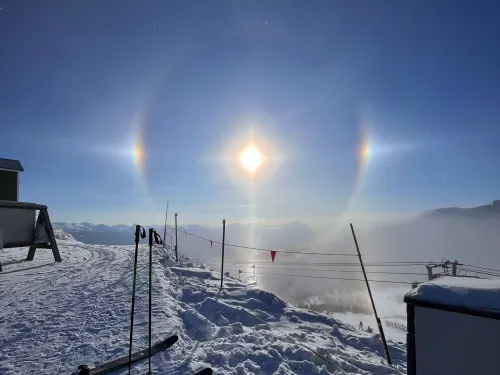Secrets of the Sun Dog: halos, parhelion and sky phenomena
Like some kind of wordless signal from the universe, a bright golden halo shone over the snowy peaks of the Canadian Rockies. At its centre, a near blinding star almost formed a compass rose. What we were witnessing that winter day, as several friends and I stood transfixed at the top of Marmot Basin ski area in Jasper, was the most vivid sundog (aka parhelion) I’d ever seen.
I couldn’t help wondering, what exactly causes the phenomenon we commonly know as a sundog? I had a vague sense of the science, but I craved the full story. Witnessing such natural phenomena, humans have always been driven to know, and where we don’t know, to mythologize.
I began to wonder not just about the science but about the cultural meanings around these sky phenomena.
Sundog science & cultural meanings
First, let's explore the scientific explanation behind the sky phenomena known as halos and parhelion, or sundogs, and then some of the cultural meanings.
Is it a halo or a sundog?
The US National Weather Service makes a distinction between halos and sundogs, the former being a second ring of light outside the sun, and the coloured light spots that often appear within them, which are technically the sundog portion. So the photo above is a halo/sundog, to be accurate, I guess.
Science of the sundog
In simple scientific terms, sundogs are part of the rainbow family of natural phenomena. A sundog, the colloquial term for a parhelion, is a phenomenon created by the refraction of light through ice crystals in the atmosphere. But what does that really mean?
How a sundog is created
"Parhelia, or sundogs, can be seen anywhere in the world at any time of the year, as long as there is a layer of ice crystals between the viewer and the sun," explains weather expert Kyle Brittain. Brittain spent several years as the Alberta bureau chief for The Weather Network, and continues to maintain a fascination in weather, particularly extreme weather events like wildfires and tornadoes. His Twitter/X handle, @badweatherkyle, will be familiar to many in Alberta.
"In many cases (especially the tropics), these come in the form of high cirrus clouds comprised of ice crystals, but in Canadian winter, we can have an abundance of ice crystals near the ground, often appearing as what we call 'diamond dust.'"
These hexagonal-shaped ice crystals lie at a horizontal angle to the sun, and essentially act as a prism. Sunlight enters the crystals, gets refracted on a 60 degree angle, and exits the other side, creating a light spot that is visible 22 degrees from its origin, Brittain explans.
"Ski hills are one of the best places to observe atmospheric optics and ice crystals because you're closer to the level of the clouds," he adds.
What creates a halo
Like a sundog, ice crystals are the root cause, but what’s different about a halo is that it is the refracting light through ice crystals within a cirrus cloud that create the ring.
Get outdoors, get more connected, get more Zen.
Sign up for ZenSeekers enews for more transformative travel inspiration.
Sundog in Greek myth
Some attribute the word sundog to the Greek, who purportedly believed that the bright lights were the dogs Zeus would walk across the sky. For the Greeks, seeing a sundog was considered to be a sign of good luck, and that sentiment appears to linger in current perception across several cultures.
Indigenous cultural meanings behind the sundog
In Western Canada, some Indigenous cultures also attribute meaning to the sundog. For the Stoney Nakoda, the sundog is a sign of hope and purpose and the bright lines that radiate out from the sun to form a parhelion have special meaning, as Helmer Twoyoungmen explains in this article from the Cochrane Eagle.
In the article, Twoyoungmen explains that the upward line refers to the elders, the downward line to the youth and the arc of the halo is a reminder of the Great Spirit. And in the naturally attuned way of many Indigenous cultures, he also notes that seeing a sundog is often a harbinger of a cold spell.
Standing on a Jasper summit, witnessing the sundog before me, that interpretation resonated for me. Bring on the colder days, and the winter rainbows that come with them, I say. The earth and its inhabitants need the cooling effect that the sundog brings, and its reminder of hope.
More Zen in nature
For more about the science behind atmospheric optics, Brittain recommends checking out the website atoptics.co.uk.
For more ways to connect to nature and the world around us, in Western Canada, sign up to the ZenSeekers newsletter.
Like Our Facebook Page



